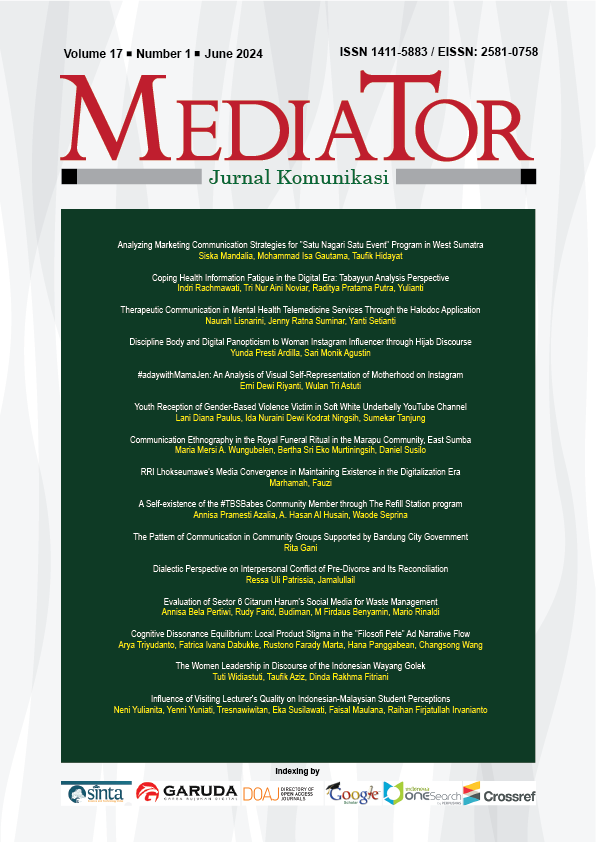Discipline Body and Digital Panopticism to Woman Instagram Influencer through Hijab Discourse
DOI:
https://doi.org/10.29313/mediator.v17i1.2661Keywords:
digital panopticism, hijab, millenial generation, panopticonAbstract
In contemporary society, the migration of interactions among millennials, particularly Muslim women serving as influencers, to digital platforms has spurred an intriguing shift. However, this transition is fraught with complexities as these women encounter digital media panopticism, constraining their liberty of expression. This study delves into the propagation of hijab discourse within millennial influencer circles via digital channels, aiming to unveil the established truths propagated by authoritative figures. Employing Foucault’s notion of panopticism, discursive practices, and Howe-Strauss’ Millennial generation, this research employs critical constructionism, qualitative methodologies, and in-depth interviews to unravel the pervasive digital panopticism shaping the disciplined digital personas of these influencers. The investigation uncovers how authorities utilize digital panopticism to regulate influencers, aligning with Foucault’s theories. This discreet strategy amplifies influence while perpetuating continuous surveillance through participatory transparency. By penalizing deviations from the hijab discourse, authorities instill fear, prompting self-discipline on social media platforms. Despite influencers’ vigilance, the opaque nature of control fosters ambiguity, highlighting the subtle yet profound impact of power dynamics in digital spaces. This observation echoes Foucault’s discourse on subtle regulatory mechanisms in contemporary society, underscoring the pervasive influence of power dynamics in digital spheres.
References
APJII. (2018). Hasil Survei Penetrasi dan Perilaku Pengguna Internet Indonesia 2017. Www.Apjii.or.Id. https://apjii.or.id/survei2017/download/WXhyvuaZroOMYlIHnAKJ8Ss6kzC3Uw
Augesti, A. (2018). Dubes Moazzam: Politikus Indonesia Jangan Main-Main dengan Isu SARA. Https://Www.Liputan6.Com. https://www.liputan6.com/global/read/3647457/dubes-moazzam
Bary, E. (2018). Trends in app downloads could bode well for these tech companies. Www.Marketwatch.Com. https://www.marketwatch.com/story/trends-in-app-downloads-could-bode-well-for-these-tech-companies-2018-09-09
Baulch, E., & Pramiyanti, A. (2018). Hijabers on Instagram: Using Visual Social Media to Construct the Ideal Muslim Woman. Social Media + Society, 4(4), 205630511880030. https://doi.org/10.1177/2056305118800308
Berkup, S. B. (2014). Working With Generations X And Y In Generation Z Period: Management Of Different Generations In Business Life. Mediterranean Journal of Social Sciences. https://doi.org/10.5901/mjss.2014.v5n19p218
Bi, S. (2018). Panopticons, Power and Pleasure: Why the Hijab is Not a Problem. Journal of Muslim Minority Affairs, 38(1), 139–141. https://doi.org/10.1080/13602004.2018.1432146
Bozovic, M. (2010). An Utterly Dark Spot. University of Michigan Press. https://doi.org/10.3998/mpub.16640
BPS. (2010). Population by region and religion. Www.Bps.Go.Id. https://sp2010.bps.go.id/index.php/site/tabel?tid=321
Cheung, T. T. T. (2014). A study on motives, usage, self-presentation and number of followers on instagram. https://api.semanticscholar.org/CorpusID:55736275
Cresci, S., Di Pietro, R., Petrocchi, M., Spognardi, A., & Tesconi, M. (2015). Fame for sale: Efficient detection of fake Twitter followers. Decision Support Systems, 80, 56–71. https://doi.org/10.1016/j.dss.2015.09.003
Creswell, J. W. (2007). Quantitative Inquiry and Research design: Choosing among five approaches. Sage.
de Veirman, M., Cauberghe, V., & Hudders, L. (2017). Marketing through Instagram influencers: the impact of number of followers and product divergence on brand attitude. International Journal of Advertising, 36, 798–828. https://api.semanticscholar.org/CorpusID:55838919
Derks, D., & Bakker, A. B. (2013). The psychology of digital media at work. Psychology Press.
Folia, R. (2017). Ingin Jadi Influencer? Begini Syarat dan Hitung hitungannya. Https://Www.IDNtimes.Com. https://www.idntimes.com/news/world/rosa-folia/syarat-jadi-Influencer
Foucault, M. (1995). Discipline and punish: the birth of the prison. Vintage Books.
Foucault, M. (2002). Power: essential works of Foucault 1954–1984, Vol. 3 ( J.D. Faubion ed.). Penguin Book.
Frederick, W. H., & Worden, R. L. (2011). Area Handbook Series: Indonesia, a country study. Library of Congress. Federal Research Division.
Galič, M., Timan, T., & Koops, B.-J. (2017). Bentham, Deleuze and Beyond: An Overview of Surveillance Theories from the Panopticon to Participation. Philosophy & Technology, 30(1), 9–37. https://doi.org/10.1007/s13347-016-0219-1
Gehring, P. (2017). The Inverted Eye. Panopticon and Panopticism, Revisited. Foucault Studies, 46–62. https://doi.org/10.22439/fs.v0i0.5341
Hosen, N. (2005). Religion and the Indonesian Constitution: A Recent Debate. Journal of Southeast Asian Studies, 36(3), 419–440. http://www.jstor.org/stable/20072669
Howe, N., & Strauss, W. (2000). Millennials Rising: The Next Great Generation. Vintage Book.
Jeko, I. (2016). Wanita Lebih Doyan Main Instagram Ketimbang Pria. Https://Www.Liputan6.Com. https://www.liputan6.com/tekno/read/2412338/wanita-lebih-doyan-main-instagram-ketimbang-pria
Jo, H. (2018). Jilbab terlarang di era orde bar. Https://Www.Historia.Id. https://historia.id/agama/articles/jilbab-terlarang-di-era-orde-baru-6k4X
Joinson, A. N. (2008). Looking at, looking up or keeping up with people? Proceedings of the SIGCHI Conference on Human Factors in Computing Systems, 1027–1036. https://doi.org/10.1145/1357054.1357213
Kavakci, E., & Kraeplin, C. R. (2017). Religious beings in fashionable bodies: the online identity construction of hijabi social media personalities. Media, Culture & Society, 39(6), 850–868. https://doi.org/10.1177/0163443716679031
Kementerian Agama RI. (2012). Tafsir Al Quran tematik : Kedudukan dan peran perempuan. PT. Sinergi Pustaka Indonesia.
Kennedy, G. (2015). Social Media: Master Social Media Marketing - Facebook, Twitter, YouTube & Instagram (Social Media, Facebok, Twitter, YouTube, Instagram). Create Space Independent Publishing Platform.
Lewis, R. (2015). Muslim fashion: Contemporary style cultures. Durham. Duke University Press.
Lister, M., Dovey, J., Giddings, S., Grant, I., & Kelly, K. (2003). New Media A Critical Introduction. Routledge.
Lyon, D. (2007). Surveillance Studies: an Overview. Polity.
M Iqbal Ichsan. (2018). Pelatih Miftahul: Mintalah IJF Telaah Hijab secara Ilmiah. Https://Www.Kumparan.Com. https://kumparan.com/kumparansport/pelatih-miftahul-mintalah-ijftelaah-hijab-secara-ilmiah-1539177639337100126
Macionis, J. J. (2007). Sociology 12th. Prentice-Hall.
Matanas, P. (2017). Lika-Liku Jilbab Sebelum Tren di Tanah Air. Https://Www.Tirto.Id. https://tirto.id/lika liku-jilbab-sebelum-tren-di-tanah-air-cfzP
Moerdijat, L. (2023). Bonus Demografi Harus Mampu Wujudkan Kesejahteraan Masyarakat. Www.Mpr.Go.Id. https://www.mpr.go.id/berita/Bonus-Demografi-Harus-Mampu-Wujudkan-Kesejahteraan-Masyarakat
Moors, A., & Tarlo, E. (2013). Introduction. In Islamic Fashion and Anti-Fashion. Bloomsbury Publishing Inc.
Nuroniyah, W. (2017). Dekonstruksi Hijab (Kajian Sosio-Historis terhadap Konstruksi Hukum Hijab dalam Islam). Al-Manahij: Jurnal Kajian Hukum Islam, 11(2), 263–280. https://doi.org/10.24090/mnh.v11i2.1301
O’Farrell, C. (2005). Michel Foucault. SAGE Publications Ltd. https://doi.org/10.4135/9781446218808
Owusu-Acheaw, M., & Larson, A. G. (2015). Use of Social Media and its Impact on Academic Performance of Tertiary Institution Students: A Study of Students of Koforidua Polytechnic, Ghana. Journal of Education and Practice, 6, 94–101. https://api.semanticscholar.org/CorpusID:142579178
Pew. (2013). Photo and Video Sharing Grow Online. Https://Www.Pewinternet.Org. www.pewinternet.org/2013/10/28/photo-and-video-sharing-grow online-2/
RI, K. A. (1965). PENETAPAN PRESIDEN REPUBLIK INDONESIA NOMOR 1/PNPS TAHUN 1965. Https://Www.Kemenag.Go.Id. https://kemenag.go.id/file/dokumen/UU1PNPS65.pdf
Roald, A. S. (2011). Women in Islam: The Western Experience. Rouledge.
Scott, G. G. (2014). More Than Friends: Popularity on Facebook and its Role in Impression Formation. Journal of Computer-Mediated Communication, 19(3), 358–372. https://doi.org/10.1111/jcc4.12067
Sebastian, Y., Amran, D., & Lab, Y. (2016). Generasi Langgas. GagasMedia.
Shihab, M. Q. (2004). He is everywhere: God’s hand behind every phenomenon. Lentera Hati.
Statista. (2018). Number of monthly active Instagram users from January 2013 to June 2018 (in millions). Www.Statista.Com. https://www.statista.com/statistics/253577/number-of-monthly-active-instagram-users/
Stevani, N., & Junaidi, A. (2021). Pengaruh Influencer terhadap Minat Beli Produk Fashion Wanita pada Instagram. Prologia, 5(1), 198. https://doi.org/10.24912/pr.v5i1.10121
Sugiharto, S. A., & Ramadhana, M. R. (2018). PENGARUH KREDIBILITAS INFLUENCER TERHADAP SIKAP PADA MEREK. Jurnal Ilmu Politik Dan Komunikasi, 8(2). https://doi.org/10.34010/jipsi.v8i2.1333
Tarlo, E. (2010). HIJAB ONLINE. Interventions, 12(2), 209–225. https://doi.org/10.1080/1369801X.2010.489695
Yow, V. R. (2005). Recording Oral History: A Guide for The Humanities and Social Sciences (2nd ed.). Altamira Press.
Downloads
Published
Issue
Section
License
Copyright (c) 2024 Yunda Presti Ardilla, Sari Monik Agustin

This work is licensed under a Creative Commons Attribution-ShareAlike 4.0 International License.























